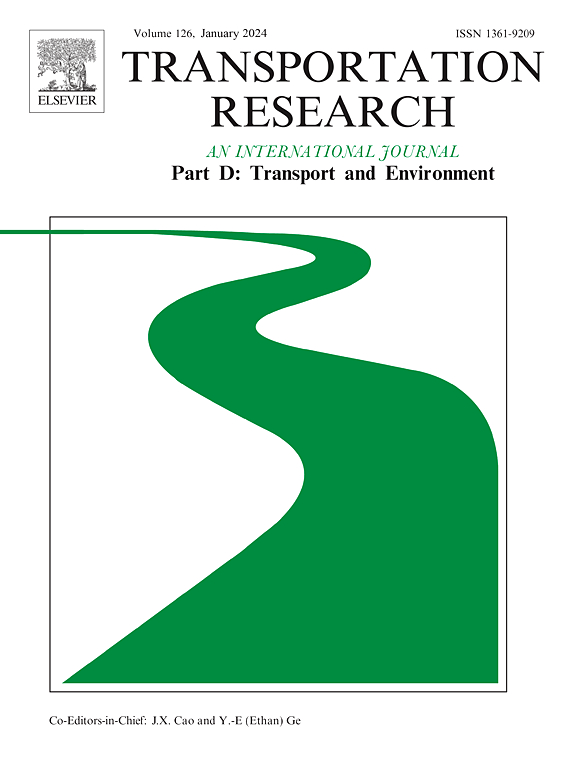研究无桩共享单车和电动单车在住宅和工作人群中的空间公平性
IF 7.7
1区 工程技术
Q1 ENVIRONMENTAL STUDIES
Transportation Research Part D-transport and Environment
Pub Date : 2025-07-26
DOI:10.1016/j.trd.2025.104922
引用次数: 0
摘要
共享微型交通工具在全球越来越受欢迎。以往的研究主要探讨了西方城市居住人口面临的与共享单车相关的空间公平问题,往往忽视了共享电动自行车系统和工作人口。本文考察了共享单车和共享电动单车的公平绩效,并考虑了中国一个城市(即温州)的居住人口和工作人口。利用基于可访问性的框架,整合了大量用户生成的出行和手机数据等多源数据,我们的研究结果表明,由于更广泛的车队可用性和分布,共享单车比电动自行车提供了更好的横向公平性。纵向公平分析揭示了居住人口和工作人口之间的系统性差异。在工作人群中,19-29岁的人更容易使用共享电动自行车,而50-59岁的人在两种类型的自行车上的可及性一直较低。相比之下,在居民中,50-59岁年龄组的可达性相对较高,而年轻的居民(19-29岁)则遇到限制,特别是共享电动自行车。非本地人群在两种模式下都处于不利地位,女性用户的可访问性略高。本研究为亚洲城市环境下的微交通公平提供了有价值的见解,为制定可持续和公平的微交通系统的政策和规划提供了启示。本文章由计算机程序翻译,如有差异,请以英文原文为准。
Examining spatial equity of dockless shared bikes and e-bikes for residential and working populations
Shared micro-mobility is experiencing growing global popularity. Previous studies mainly explored the shared bike-associated spatial equity issue faced by the residential population in Western cities, often neglecting shared e-bike systems and the working population. This paper examines the equity performance of both shared bikes and shared e-bikes, and considers both residential and working populations in a Chinese city (i.e., Wenzhou). Utilising an accessibility-based framework integrating multi-source data like massive user-generated trip and mobile phone data, our results show that shared bikes provide better horizontal equity than e-bikes due to broader fleet availability and distribution. Vertical equity analysis reveals systematic disparities between residential and working populations. Among working populations, individuals aged 19–29 enjoy better access to shared e-bikes, while those aged 50–59 face consistently lower accessibility across both bike types. In contrast, among residents, the 50–59 age group show relatively higher accessibility, whereas younger residents (19–29) encounter limitations, particularly for shared e-bikes. Non-local populations are disadvantaged in both modes, and female users exhibit slightly higher accessibility. This study provides valuable insights into the micro-mobility equity in Asian urban contexts, offering implications for policy-making and planning to develop sustainable and equitable micro-mobility systems.
求助全文
通过发布文献求助,成功后即可免费获取论文全文。
去求助
来源期刊
CiteScore
14.40
自引率
9.20%
发文量
314
审稿时长
39 days
期刊介绍:
Transportation Research Part D: Transport and Environment focuses on original research exploring the environmental impacts of transportation, policy responses to these impacts, and their implications for transportation system design, planning, and management. The journal comprehensively covers the interaction between transportation and the environment, ranging from local effects on specific geographical areas to global implications such as natural resource depletion and atmospheric pollution.
We welcome research papers across all transportation modes, including maritime, air, and land transportation, assessing their environmental impacts broadly. Papers addressing both mobile aspects and transportation infrastructure are considered. The journal prioritizes empirical findings and policy responses of regulatory, planning, technical, or fiscal nature. Articles are policy-driven, accessible, and applicable to readers from diverse disciplines, emphasizing relevance and practicality. We encourage interdisciplinary submissions and welcome contributions from economically developing and advanced countries alike, reflecting our international orientation.

 求助内容:
求助内容: 应助结果提醒方式:
应助结果提醒方式:


